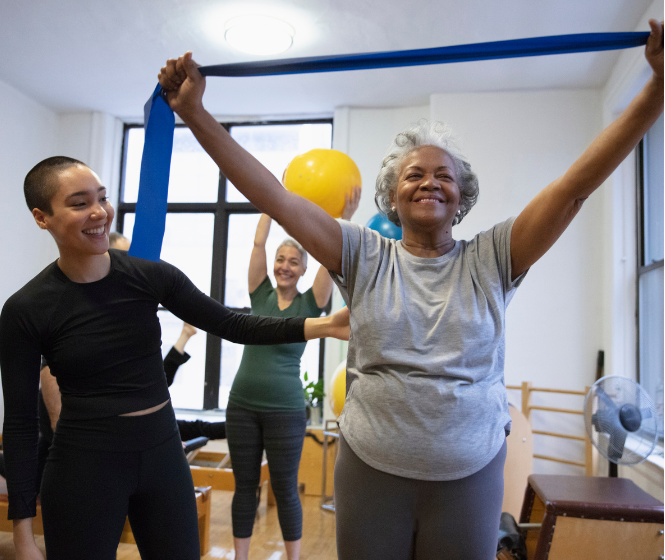Power Through: Consistent Strength Training To Keep You Going
August 24, 2022

You may have read previous posts in agebuzz touting the value and health benefits of strength training. Whether lifting free weights or kettlebells, using resistance bands, or just moving your own body weight against the forces of gravity, there are so many reasons as you age that this type of exercise needs to be an ongoing part of your everyday life. Do you have trouble getting out of a chair? Carrying your groceries from the car to the counter? Getting up from the floor after a yoga session? These examples of everyday activities- and the challenges you have performing them- are just one example of why consistent, regular strength training is key to keeping you independent as you age. But there are also a host of serious health concerns that require strong and active muscles to avoid many of the conditions that are associated with aging. As a recent post from the National Institute on Aging (NIA) put it, “While there is no way to “stop the clock,” it’s possible for many older adults to increase muscle mass with exercise, which can help maintain mobility and independence into later life.” And the best recipe for maintaining your physical functioning and avoiding disability as you get older? NIA researchers say it’s walking (!) in combination with resistance (strength) training.
Before we get into some strength training strategies, let’s review a few other reasons why strength training can be valuable for your health. First, a recent study published in the British Journal of Sports Medicine found an association between strength training and protection against chronic disease as you age, including chronic inflammation, diabetes, heart disease, and cancer. How does that happen? It appears strength training may trigger protective body reactions, including reducing blood sugar, lowering blood pressure, reducing fat, and discouraging a constant state of inflammation. As NIA researchers also confirmed, “When you do resistance or strength training, very important chains of molecules that relay signals between cells are affected, and these changes linger in the body for hours after exercise, building up a cumulative positive effect.” Beyond your physical well-being, there also appear to be substantial benefits to your brain and cognition. New research published in JAMA Network Open identifies the muscle mass you acquire from strength training as a modifiable factor in reducing the risk of dementia later in life. What these researchers found was that lower muscle mass is significantly associated with faster cognitive decline, particularly executive functioning. Given that muscle mass can be improved in older adults, this may be one way to modify a dementia risk and protect older adults from cognitive decline. To find out more, grab a hand weight and read here. In fact, it appears that the brain and your system of muscles have “a robust molecular language spoken” between them, constantly sending each other signals back and forth, leading to the conclusion that “in a very tangible way our lifelong brain health depends on keeping our muscles moving.”
So how can you use strength training to build muscle as you get older? No one is expecting you to spend hours at the gym or transform your body into a Jack LaLanne look-alike. Instead, you need to think about steady movements throughout the day, leading perhaps to a total of 30-60 minutes a week of strength training for optimal results. Over at LiveStrong, there’s a set of strength-training exercises (including video demonstrations) that just require you to have a set of dumbbells in your home and 20 minutes to work your way through large and small muscle groups. Recognizing that building and maintaining strength probably requires a multi-faceted approach, the strength/resistance training portion will likely depend on how much weight you’re holding, how many reps and sets you do, how long your routine is each time, and how frequently you do it. The key thing to remember is that even if you’ve sat on way too many couches during your lifetime, you’re never too old to start up a training routine. Finally, as the NIA makes clear, when starting up or devising a strategy, don’t compare yourself to younger people. Set realistic goals, keep it fun and simple, and recognize this should not be a burden but rather an enjoyable endeavor with tangible benefits for your body and mind.







